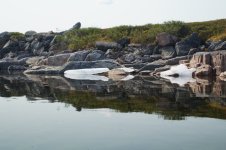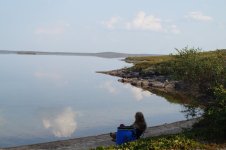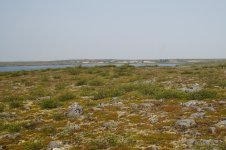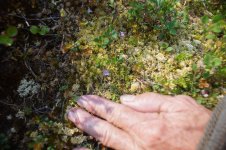Saturday, July 9. We crawled out of the tent at 5:00 a.m. A beautiful calm morning. A red sky, however, dominated the horizon. And, as you know, that means potential trouble, as in red sky in morning, sailors take warning. That suggests that canoeists should also take warning from a red sky in the morning.
This adage, in fact, has a scientific/meteorological basis. In the mid latitudes, storms commonly travel from west to east, pushed along by the jet stream. A rising sun in advance of an approaching weather system illuminates the approaching mid- and high-level clouds to create a red sky in the morning. Some sources say that the mid latitudes occur from about 30 to 60 degrees north or south of the equator. Kathleen and I are camped north of 60 degrees, so are not technically in the mid-latitudes. Other sources say that the mid latitudes in the northern hemisphere occur between approximately 23 and 66 degrees north of the equator, which places us within the threat of red sky in morning, canoeists take warning. We shall see. If the current calm conditions hold, we might reach the Lynx Creek esker today, only about 35 km (22 miles) away.
We put on the water in a stiff breeze. Not too bad, but worrisome. An hour later we went ashore to rest, as the wind had intensified. We were close to where Whitefish Lake narrowed a bit, where we might benefit from a shorter fetch.
Thirty minutes later we faced strong headwinds, accompanied by large, rolling waves. We tried to round a point to seek shelter in a small bay, but were pushed up against shoreline boulders. We hopped out and tied the canoe, stern first, onto a small tree. The canoe crashed heavily against the boulders, but seemed secure. So we scrambled up the bank, and sat on the leeward side of a large rock, just like Samual Hearne reported on his overland trip to the Coppermine River in 1770-1771, as presented in Farley Mowat’s book
Tundra:
“On the 3rd of July the weather was again bad, but we made shift to walk ten or eleven miles, until we were obligated to put up because of not being able to see, due to the drifting snow. By putting up, no more is to be understood than we got to leeward of a great stone, or into the crevices of rocks, where we smoked our pipes or went to sleep until the weather permitted us to proceed.”
Compared to Hearne’s conditions, our situation was much better. We had nothing to complain about. After about an hour we snacked on gorp, and discussed our options, which weren’t welcoming at all. If the wind stopped by 1:00 p.m. we could still reach the Lynx Creek esker today. This option looked extremely unlikely, so we decided to search for a place to camp. All nearby potential sites were either hummocks, bogs, or pure rock. Kathleen and I couldn’t have landed at a more miserable location. We had to push on.
Back at the canoe we struggled to pull/push it to the slightly more sheltered cove. Rollers repeatedly pushed the canoe back up against and onto the boulders. We were making no progress. Kathleen slipped and tumbled into the cold water three times, badly bruising her legs on the rocks. I was breathing heavily from the struggle, but didn’t suffer a stroke. Quite reassuring for an old man with high blood pressure. But then again, that’s why I’ve been taking blood pressure medications for many years, now.
We finally reached the cove, beached the canoe, and walked over to the next cove to assess camping. We found a nice, flat piece of tundra. We hurried back to the canoe, and paddled with difficulty around the point into our somewhat sheltered cove with acceptable camping.
Working quickly we got the tent and fly up mere seconds before a deluge overwhelmed our site. Thirty minutes later, the rain seemed to stop, which allowed us to bring our Therm-a-Rests and sleeping bags into the tent, again mere seconds before a second deluge assaulted us. We crawled into our sleeping bags to warm up, and to doze.
We should have taken pictures of our current predicament, as a picture is worth a whole lot of words, a thousand, they say. But we didn’t. And I don’t want to compose a thousand words to substitute for the missing picture. But contemplate these nine words:
Low, bleak tundra. Crashing waves. Dark sky. Pouring rain. We were enjoying a true Barren Grounds experience. Just what we came for.
We were camped at 62º 35’ N, 106º 54’ W. Still about 25 km (15 miles) to the Lynx Creek esker, and 35 km (22 miles) to the Lynx Tundra Lodge, where we have reservations for July 13 and 14. We need calm weather.
At 6:30 p.m. we somewhat enjoyed a quick supper of spicy chicken noodle soup, with cheese and crackers. Blue sky began poking through the greyness above a finally calm Whitefish Lake. People often ask us if we work out before embarking on these physically demanding trips. I’ve always said there’s plenty of time to toughen up on the trip itself. This seems to be happening, even at our age. I’m not nearly as tired now as I was a couple of days ago, despite our most difficult day so far.
(No pictures today.)
Sunday, July 10. Kathleen stepped outside the tent at 3:00 a.m. “There’s a dense fog on the eastern shore, Michael. It’s not really raining. Just a slight drizzle, and the lake is calm. We might be able to paddle today.” Moments later, the slight drizzle became actual rain, driven by a crisp wind. I could hear waves lapping onto the shore. The wind increased, and the lapping on-shore waves became louder. Not exactly crashing, but more than lapping. More like running onto shore.
I stepped outside at 6:15 a.m. Medium sized waves on the lake. Back in the tent I reported that we could paddle in this, but probably wouldn’t want to make the upcoming open crossing of approximately 1.0 km (0.5 miles). “Then we shouldn’t go,” Kathleen said. She was right, of course. We were content in the tent, and were approximately on schedule. No reason to push ourselves in uncomfortable paddling conditions. We can just enjoy our company in the tent. Kathleen noted that canoe trips teach patience and humility. In our city lives we sometimes believe we are in control of events. Out here, on the Barren Grounds, circumstances are definitely beyond our control.
Around 7:15 a.m. I could no longer hear waves lapping up onto the beach. I peered outside. Calm, with just a slight wind. We might be able to paddle soon.
At 9:00 a.m. Kathleen got up out of necessity, and heated up our tea from last night. “Still drizzling, Michael, but the sun is poking through the clouds.” The rain returned in earnest before Kathleen crawled back into the tent.
For lunch we prepared Raman-style noddle soup, with salami, figs and dried pineapple rings. Finally, at 2:30 p.m. the sky finally appeared to be clearing, with very little wind. “I think this is more than just a brief break in the storm. I think we should go.”
“I agree.”
We quickly broke camp, loaded the canoe, and headed out onto Whitefish Lake. We both felt so good to be paddling and making progress. After about two hours we stopped to take a GPS reading. Again, we were not nearly as far as I thought. What is wrong with me? I’ve never had this much trouble navigating. Well, for one thing, as you remember, I didn’t have a watch, so didn’t know how long we had been paddling. I was only guessing that we had been paddling about two hours. And for a second thing, I hadn’t been taking compass readings. Why take compass readings when I already believed I knew where we were? Kind of foolish attitude on my part, though. The compass hangs around my neck—takes only a few seconds to get the compass reading. Three seconds later my compass confirmed our position.
At 6:00 p.m. stopped for gorp and a GPS reading. Bingo! Exactly where I thought we were. “No need for my compass now, Kathleen. We just need to follow the shore, and then turn right into the narrows leading to the river that takes us to Lynx Lake.”
Again, all this embarrassing hubris coming out of my mouth. Compass readings require only a few seconds. I’ve always taken many compass readings on our canoe trips. It’s neither difficult nor inconvenient. Take the dang compass readings!
I should mention that Kathleen and I have spent a lot of time pushing and pulling our canoe off of and through boulders while rounding points and landing on beaches. Barren Ground lakes are generally shallow near shore, with many boulders guarding access to the beach. I should have been recording how many times we had already hung up on boulders. I should have been tallying how many times we had to jump out in thigh-deep water to yank the canoe free. The total is
many.
Too many.
“Kathleen, I’m heading out a little way offshore to avoid grounding out on boulders.”
“But I thought you said that we we need to follow the shore to turn into the narrows. Now you’re not on the shore, Michael.”
“But I can see the shore.”
“Don’t you think we should actually snug up against the shore?”
“No need to do that. We’ll be able to see the narrows from here.”
A few minutes later we entered what I truly believed to be the narrows leading to the river that would take us to Lynx Lake. “This doesn’t seem right to me, Michael. I think this is just a side bay. I don’t see an outlet down there.”
“I’m a little worried too. But I think I see current down there. Do you see current?”
“I think so. I’m sorry to have doubted you.”
Twenty minutes later we reached the bottom of a side bay. We were not in the narrows. There was no river that would carry us to Lynx Lake. A GPS reading confirmed that we had passed by the right turn into the narrows. My compass would have immediately established that our current direction was obviously wrong—that I had taken us into a side bay, and not the narrows leading to Lynx Lake.
These two events elicited a lot of discussion between Kathleen and me. The conversation went something like this.
“I’ve always been happy to trust your excellent navigational skills to get us where we’re going, Michael.”
“And, Kathleen, I’ve always appreciated your unwavering confidence in my judgement.” (Note: I placed quotes around the two previous statements, even though they might not represent exactly what we said.) This was undoubtedly the worst navigational day of my life. Just take the dang compass readings.
Anyway, we paddled back out of the side bay, and over to the shore. A few minutes later, we saw a channel curving to the right. The entrance to the narrows had been obscured by the land falling away when we paddled by 40 minutes ago. I took the dang compass reading. Yes. This was it.
We soon found ourselves in the narrows, heading toward the rapid between Whitefish and Lynx Lakes. We descended the shallow river slowly, bumping and grinding over rocks. We soon hung up on a boulder, and I jumped out to pull us free. We headed to the outside bend, seeking deeper water. We heard the rapid before seeing whitewater up ahead. We eddied out on river left to scout. An obvious trail existed through a dense clump of spruce. Other adventurers had passed this way. We walked down the trail and studied the rapid. No problem. Only a shallow riffle.
“All we gotta do is head down the middle and keep the canoe aligned with the current.”
“Yeah, the main problem is to make sure we don’t ground out or broach on a boulder.”
Back in the canoe, we shoved off toward the rapid. Probably less than a minute later, the excitement was all over. Or so we thought. Up ahead another stretch of whitewater posed a potential challenge.
“Do you want to get out and scout?”
“No. It’s not as much as what we have already run. Let’s just go.”
A little after 9:00 p.m, we reached the southern end of Whitefish Lake, where we drifted slowly in absolute calm and silence, like canoeing on a mirror. We paddled through the gap, and turned west, looking for our 2001 Lynx Creek esker camp. After about 15 minutes Kathleen said, “We should have been there by now Michael. We must have gone by. Let’s head back. I think I already saw the esker. I should have said something.”
So we turned abound and paddled all the way back, to the first beach west of the gap. “I think this might be it, Michael.”
We landed on shore to investigate what was truly a horrible site with a brackish pond, probably filled with vicious, frenzied mosquitos. “I don’t think this is it, Kathleen.”
“I don’t think it is either. What do we want to do?”
“Well, I don’t want to stay here. Do you like this spot, Kathleen?”
“No.”
“Neither do I. In fact I hate it. Let’s head back and look for our favourite camp—our Lynx Creek esker camp. That’s why we came. It’s on the itinerary. We gotta stay there.” (Note: I was certain that we hadn’t paddled far enough up Lynx Creek. There’s no way we would have not recognized its truly beautiful esker campsite. Based on my recent navigational failures, however, I thought it best to say nothing.)
We headed back west, and found our camp just around the bend where we had turned around. We beached and set up camp, harassed continually by the worst horde of mosquitoes so far on the trip. Into the tent for our nightly sip of brandy, and then into our sleeping bags.
During the paddle the western horizon glowed red, perhaps good news. You know that old adage red sky at night, sailor’s (and canoeists) delight. Several sources indicate that if the sun is setting as a weather system exits, and high pressure is building, then the departing clouds would be illuminated. This creates a red sky at night with fair weather to follow.
Kathleen and I both woke up in the middle of the night. “It’s cold!”
“Very cold.”
We both put our fleece jackets back on. Kathleen even pulled her overbag onto her sleeping bag. I finally warmed up, wondering what the temperature was—too tired, though to get the thermometer out of the map case. The cold temperature indicated that the heavens had cleared. The red sky at night had indeed accurately predicted a coming high pressure system.

Clearing Sky and Calming Waves At 2:30 p.m.

Time To Pack Up And Go

Exactly Where I Thought We Were At 6:00 p.m.

Calm And Silent At The Southern End Of Whitefish Lake, 9:20 p.m.























